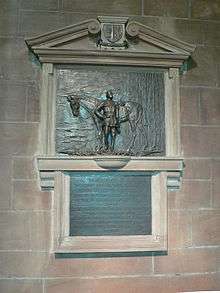Lord Hugh Grosvenor
Captain Lord Hugh William Grosvenor (6 April 1884 – 30 October 1914) was a son of Hugh Grosvenor, 1st Duke of Westminster and his second wife, formerly The Hon. Katherine Cavendish.

WW I service and death
Grosvenor was the commander of C Squadron, 1st Life Guards, and was killed in action, aged thirty, during World War I.[1]
Lord Grosvenor's unit deployed at Zandvoorde and participated in the First Battle of Ypres. In an exposed position for six days they held the shallow trench in front of Zandvoorde on the forward slope. Grosvenor sent a message back to his headquarters -[2]
'There appears to be a considerable force of the enemy to my front and to my right front. They approach to within about seven hundred yards at night. Our shells have not been near them on this flank'
The British trenches were attacked and the cavalry fighting as infantry was overwhelmed in hand-to-hand fighting. By 08.30 on the morning of 30 October 1914 news reached HQ that the 7th Cavalry Brigade had been forced off the Zandvoorde Ridge. With no survivors there was initially some confusion as to Lord Grosvenor's fate.[2]
The 1st Life Guard's war diary noted the action at Zandvoorde -[3]
Zandvoorde-Oct 30 6am Heavy bombardment of position opened. At 7.30am position was attacked by large force of infantry. This attack proved successful owing to greatly superior numbers. Regiment retired in good order about 10.00am except C Squadron on the left flank from which only about ten men got back. Remainder of Squadron missing. Also one machine gun put out of action.
He was initially reported as being made a prisoner of war. The Times reported a comrade stating that Lord Grosvenor was wounded and his horse killed following a 'gallant charge to draw the fire of the German field batteries'. After the withdrawal of the Life Guards he was believed captured after failing to mount a second horse.[4] However, he was later believed to have been killed in action on 30 October 1914 rather than captured as initially thought.[5]
Having no known grave, he is commemorated on the Menin Gate Memorial, Ypres.[1]
Family
He married Lady Mabel Crichton, daughter of John Crichton, 4th Earl Erne and his wife, the former Lady Florence Cole, daughter of William Cole, 3rd Earl of Enniskillen, on 21 April 1906.
Children of Lord and Lady Hugh Grosvenor:
- Gerald Hugh Grosvenor (1907–1967), later 4th Duke of Westminster
- Robert George Grosvenor (1910–1979), later 5th Duke of Westminster
Polo
He was one of a number of British polo players who died in World War I.[6]
References
- CWGC entry
- "Hugh William GROSVENOR". www.masonicgreatwarproject.org.uk. Retrieved 4 January 2019.
- 1953-, McCrery, Nigel (2015). Final Wicket : test and first class cricketers killed in the Great War. Barnsley: Pen & Sword Military. ISBN 978-1473864191. OCLC 918997458.CS1 maint: numeric names: authors list (link)
- "Lord Hugh Grosvenor". The Times (40741). 2 January 1915. p. 10.
- "Deaths". The Times (42056). 24 March 1919. p. 15.
- Horace A. Laffaye (2009). The Evolution of Polo. McFarland & Company. ISBN 978-0-7864-3814-3.
It is very true that the First World War robbed the British of some of their top and most promising players: Geoffrey Bowlby, Harold Brassey, Leslie Cheape, Noel Edwards, Francis and Rivy Grenfell, Lord Hugh Grosvenor, Brian Osborne, Bertie Wilson...